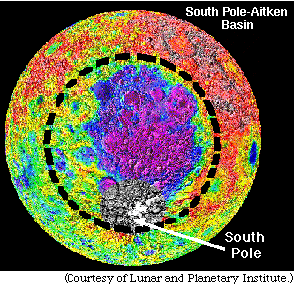
| Project Home | About the Scans | Browse Gallery | Image Map | Support Data | Resources | Ephemeris |
Featured Image - 07/14/2009
Aitken Crater
The largest and presumably oldest impact basin on the Moon is the South Pole-Aitken (or SPA) basin, so-named because SPA's circular rim stretches from the lunar south pole to Aitken crater (Figure 1) on the lunar farside, a distance of almost 2200 kilometers (Figure 2). Aitken crater (135 km in diameter) itself is mapped as an Imbrian-aged feature, and its floor is covered in a small puddle of mare basalt. Although lunar scientists had a fairly good idea that SPA existed from Apollo data and 1960s-era telescopic observations, SPA itself was not fully mapped until the Clementine mission of 1994 returned a global multispectral and topographic dataset. Clementine data revealed that the SPA contains both the lowest elevations on the Moon (almost 12 km deep) and puddles of mare basalt, unlike the rest of the lunar highlands.
Figure 1.Aitken Crater defines the northern rim of the South
Pole-Aitken basin (Apollo Image AS17-M-0481 [NASA/JSC/Arizona State University])
Why is SPA so important? Aren't all impact basins just big craters?
SPA is a bit of an enigma, and there are two big scientific questions that lunar scientists would like to answer using data from both the new armada of lunar spacecraft that are returning data from the Moon and future human exploration. SPA's tremendous size implies that the impact should have been large enough to expose the molten lunar mantle and inundate the basin with mantle materials. However, while the Lunar Prospector spacecraft detected geochemical anomalies within SPA (specifically, elevated amounts of thorium, an element associated with enrichments of KREEP materials) they are nowhere near what models predicted. Lunar scientists aren't sure if the mare basalts found inside SPA are representative of mantle materials or even formed in relation to SPA formation. Nevertheless, if mantle materials are exposed anywhere on the Moon, the most likely location would be in SPA, and exploration and sampling of the SPA basin itself could redefine our admittedly sketchy understanding of the evolution of the lunar crust and interior, which in turn would enable us to better understand the history and formation of terrestrial planets like Earth.
Figure 1. Graphic showing the position of the South-Pole Aitken
basin based on Clementine laser altimetry data (Image courtesy LPI).
Another fundamental question concerns the timing of the SPA impact. Because the Apollo samples were collected by human explorers in the field, their context is relatively well understood. Laboratory analyses and other techniques such as crater counting using remote sensing data have allowed planetary scientists to derive a rough chronology for the formation of many of the large basins on the lunar nearside, including Imbrium, Serenitatis, and Nectaris. This chronology, in turn, was extended (with some adjustments) to the other terrestrial planets and even the outer solar system. SPA is so large that it must have been formed by a large impactor, which means we can infer two things. First, SPA was probably one of the first basins to form on the lunar surface. Second, SPA probably formed early in the history of the Solar System, when large-scale planetesimals were commonplace. The early Solar System was a bit of a shooting gallery, so much so that lunar scientists now think that the impact of a Mars-sized planetesimal on early Earth was what formed the Moon in the first place! The impactor which formed SPA wasn't Mars-sized, but was larger than than the impactors which formed the other major lunar basins.
Many of the radiometric age dates from Apollo samples determined for major basins on the lunar nearside cluster at about 3.85 billion years old, which has led some lunar scientists to propose the "Lunar Cataclysm" hypothesis. According to this theory, most of the great lunar basins formed between about 3.9 and 3.8 billion years ago as part of a mass influx of material from somewhere else in the solar system, possibly related to the formation of Neptune and Uranus. The other school of thought is that the major basins simply repesent the tail-end of a nearly continuous bombardment, starting with the formation of the Earth-Moon system, and continuing until about 3.75 billion years ago.
Answering this important question requires samples and fieldwork within the South Pole-Aitken basin itself, with profound ramifications for science. If SPA really formed as part of a cataclysmic bombardment contemporaneously with the other lunar basins, it would force planetary scientists to reevaluate what is currently thought about the geologic histories of the other terrestrial planets, such as Mars and Mercury. However, just saying "sampling and fieldwork is required" really oversimplifies the challenge. The geology of SPA is anything but simple. Numerous impacts have scarred the surface of SPA - even other impact basins. Distinguishing samples from the smaller impacts within SPA and the formation of SPA itself will be a major challenge, requiring sample collection from numerous localities identified using remotely-sensed data from LRO and other lunar missions within SPA, coupled with years of fieldwork. In other words, it is the perfect sort of lengthy investigation enabled by a permanent lunar base. Several of the notional design reference potential human exploration sites selected by NASA's Project Constellation as areas of intense study by NASA's Lunar Reconnaissance Orbiter are near or within SPA. Future human exploration will settle this important scientific question!
For more information, read:
The Crazy
Mixed-Up Lunar Crust, Planetary Science Research Discoveries.
Uranus,
Neptune and the Mountains of the Moon, Planetary Science Research
Discoveries.
Lunar
Meteorites and the Lunar Cataclysm, Planetary Science Research Discoveries.
Tweet
![]()

|
|
Space Exploration Resources |
|
 LPI LPI
|

